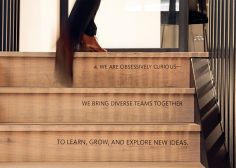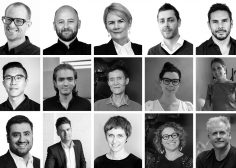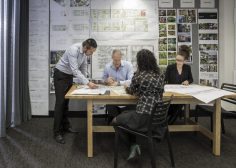
From growing your business, to marketing, finance, leadership, IT and business systems, we’ve got all your bases covered with professional advice and insight. Up first we look at the business foundations necessary to enable sustained success and growth.
In Australia, we’ve been seeing strong economic conditions, albeit challenging, and it looks set that this will only continue. But something we often realise when working with architects, engineers and designers (AED) is that the current opportunity to achieve strong and sustained profitability is not necessarily being realised.

We know that there are increasing competitive pressures, combined with a subsequent requirement to produce enhanced services for diminishing fees. The profession is delivering more value for less, and as architects, that?s what you innately do. So how can the industry position themselves for future growth and meet the challenges of increasing competition, technological changes, a changing workforce, and potential ownership transitions?
The answer is that if you want to succeed in today?s environment you need a stronger commitment to and focus on resource, financial, and project management practices ? the kind that can bring long-term goals to fruition.
Typically in architecture, engineering and design businesses, 75 per cent of business profits are generated from roughly 25 per cent of the projects. Below we outline some key principles to consider if you want to keep your practice growing from strength to strength.
Typically in architecture, engineering and design businesses, 75 per cent of business profits are generated from roughly 25 per cent of the projects.
Crunch the numbers of your projects
The most critical component of effective project performance is having oversight of the numbers.
This doesn’t just mean having a finance person looking at the project results, but making sure the project leaders understand the financial status of the project and its impact on the business. When it comes to project communication, it means communicating the project status to the client, subcontractors and the entire project team that is involved and you need a system for this, says Callum Bruce, Head of Business Systems at Management for Design.

Set a benchmark Then get familiar with even more numbers
All project and resource management best practices mean nothing without the strong financial control and understanding to keep your business ahead of the competition. Know what your metrics are, and how you are currently performing.
Performance metrics are critical to the health of architecture and design firms. The specific metrics that we recommend you measure and track are:
– Fees per hour worked
– Revenue per technical person
– % complete / % hours used
– Project profit
– Work generated
– Project backlog
– % utilisation
Accountability starts at the top
The leaders of the business directors, principals, associates can’t expect the responsibility for project performance to sit entirely with the project leader. The business leaders need to show the way, they need to develop and expect a culture of accountability and this starts at the top.
Leaders need to expect and be involved in project budgets, scope expectations and project performance for their projects.
By developing and investing in a culture of accountability and project control, design businesses can ensure that the most important assets your people resources understand the underlying purpose, skills and profit-increasing practices.
Leaders need to expect and be involved in project budgets, scope expectations and project performance.
It’s all about resourcing at the end of the day
Although some would consider this as obvious, we often encounter practices that lack insight into resourcing across the studio, i.e. who is working on what and when, who is available, who is utilised and underutilised, and what are the resource requirements moving forward.
Who is working on what and when, who is available, who is utilised and underutilised, and what are the resource requirements moving forward?
By having an effective integrated resource management system, you can steer your team and their work through obstacles and scope changes as they arise ? adding and subtracting resources as needed. Which, at the end of the day, will increase your ability to deliver projects when you say you will.
Know exactly where your projects are tracking
Regular % complete calculations are a method of measurement that is required for all fixed (lump sum) fee projects. Alongside this, the key people must understand what their project deliverables and their total estimated resource costs are expected to be are at any given time.
Tracking actual hours against expected hours can be a key source of information for addressing productivity.
‘Often, what you invoice and how you invoice does not always follow the per cent complete’, says Carla Dexheimer, Financial Controller, Management for Design.

Beware of scope creep
Out-of-scope management is based on the fact that projects have many distinct phases, all of which are prone to widespread design and documentation changes.
By clearly articulating, planning and agreeing the scope of the project up front, project leaders can effectively eliminate the potential for their firm to move into a ‘grey area’ when changes arise where neither the firm nor the client is in agreement about whether the changes are part of the agreed scope, the timing or pricing.
Businesses need to develop and stick to a consistent approach (a system) and a culture that supports the system, to capture work that is outside of the scope of services.
At the end of the day, you won’t deliver the profit you could if the changes fall back on the business, simply because it wasn’t clear what would and wouldn’t be included.
At the end of the day, you won’t deliver the profit you could if the changes fall back on the business.
Avoid re-work
Our research indicates that re-work can add up to 40 per cent to project costs, and typically accounts for 10-20 per cent of project activity.
In fact, re-work is one of the primary factors contributing to mediocre performance and productivity of projects and businesses. This can include design changes, unresolved designs and related documentation, documentation errors, inadequate or unresolved co-ordination, and ineffective project management.
This is not an easy fix, it requires the business leaders to focus on, and commit to, an effective design management process, quality control, regular review, open communication and accountability.
Re-work is one of the primary factors contributing to mediocre performance and productivity of projects and businesses.
The first step towards financial stability in the current landscape is to ensure that your firm is managing and executing profitable projects across the board. By implementing best practices in project and resource management your business will be ahead of the competition and equipped to make the decisions required to achieve long-term growth and success.
Robert Peake is the founder of Management for Design, a company that works exclusively with the architecture, engineering and design industry. Robert has over 30 years of experience and brings expertise in strategic direction, financial and business management, systems, operations and performance.















